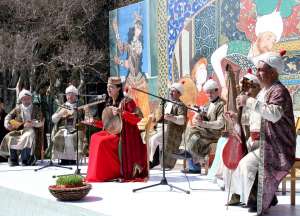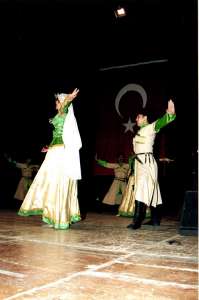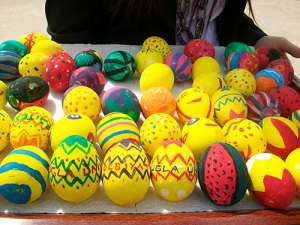NEVRUZ
- Esra Ekingen
- October 3, 2021
- 1:43 pm
Nevruz is widely celebrated in the northern hemisphere, particularly in societies that speak Turkish and Persian. Nevruz comes from the Persian words nev and ruz. In Turkey it is also called Nevruz-I Sultan, Sultan Nevruz, Navrız, Newroz, Noruz, Mart Dokuzu (March 9th), Gün Dönümü (The Turning of the Day), Yılsırtı (The Ridge of the Year), Yumurta Bayramı (The Egg Holiday). Nevruz actually means “new day” and is a celebration of spring that is regarded as the first day of the year in many societies. According to the Gregorian calendar, Nevruz begins on March 21st.
Recognized as the beginning of farming activities in agricultural societies and animal husbandry in nomadic societies, Nevruz creates an environment where information about nature and the universe is used and a number of practices take place. These practices are performed in the belief that they will bring abundance and blessing. At the same time, they strengthen the feeling of identity between individuals and communities by reinforcing social bonds.
Holidays create common cultural ties that bring individuals and communities closer and integrate them, while bringing to light values on the verge of being forgotten and passing them down to future generations. As the beginning of spring, Nevruz symbolizes rebirth and includes such positive sentiments as well-wishing, desire and hope for the future. Nature is not the only thing thatis reborn and renewed with enthusiasm during Nevruz. People also cleanse and rejuvenate themselves physically and spiritually, which leads to rejuvenated emotions and ideas. Therefore, Nevruz represents not only the excitement and joy of a holiday with the rebirth of nature but also the hopes and wishes humans entertain.
The Nevruz holiday and celebrations create one of the best settings for transmitting oral culture, the knowledge and experience of nature and the universe as well as community rituals and practices in Anatolia from one generation to the next. When viewed from this perspective, Nevruz is one of the best examples of intergenerational communication.


As is the case with all holidays, cleanliness plays an even more important role during the Nevruz Holiday. There is a general cleaning of homes and streets prior to Nevruz. During the celebrations, people make a point to wear clean or new clothes. Among the characteristics of the Nevruz celebrations is the fact that the Nevruz celebration area is literally a rainbow of color with vibrant outfits, flying kites, tapping eggs, people gathered around a large fire and jumping over it. Games that focus on bidding winter farewell and welcoming spring are also observed during Nevruz celebrations. One of the common practices that takes place during Nevruz is a type of fortune reading where interpretations of wishes that people make about what they want in the future are given by reading various signs.
In 2009, Nevruz was added to the Representative List of the Intangible Cultural Heritage of Humanity with a joint application from Azerbaijan, India, Iran, Kirgizstan, Pakistan, Uzbekistan and Turkey. Registering Nevruz on UNESCO’s Representative List of the Intangible Cultural Heritage of Humanity in 2009 as a joint file was an extremely positive contribution to efforts at creating an atmosphere of cultural dialogue, respect and understanding between societies that speak different languages, practice different religions and have different ethnic roots.
In 2010, the International Organization of Turkic Culture (TÜRKSOY) coordinated Nevruz celebrations at the UNESCO General Headquarters in Paris, at the Strasburg Music and Congress Hall, and in 2011 at the United Nations (UN) General Assembly Hall and in Washington.
The Nevruz International Workshop was held at Gazi University on March 30, 2012. The workshop was attended not only by Azerbaijan, Iran, Kirgizstan, Uzbekistan and Pakistan, all parties to the Nevruz file on UNESCO’s Representative List of the Intangible Cultural Heritage of Humanity, but also by experts from Tajikistan and Kazakhstan, who want to join the file. Throughout the workshop, countries gave presentations about protection work they conducted for Nevruz between 2009 and 2012 or that they planned to conduct with a focus on Nevruz Celebrations. As part of the first phase of the project, Turkey converted data obtained from fieldwork and visual documentation performed by General Directorate of Research and Training into a short documentary which was presented during the workshop. In the following process, lastly Iran has been the moderator for the extension of the state parties to the multinational file and various activities have been carried out among the state parties. An extensive file preparation meeting was held in Iran/Tahran on 2-6 March 2015 with the participation of Afghanistan, Azerbaijan, Iran, Iraq, Kazakhstan, Kyrgyzstan, Pakistan, Tajikistan, Turkey, Turkmenistan and Uzbekistan and the file was submitted to UNESCO in 2015 by renewing its extent to include Afghanistan, Iraq, Kazakhstan, Tajikistan and Turkmenistan leading to a total of 12 states parties. Nevruz has been inscribed on the Representative List with the decision taken at the meeting of 11th Intergovernmental Committee for the Safeguarding of the Intangible Cultural Heritage held in 2016 November in Ethiopia/Addis Ababa. This decision also renewed the previous decision taken in 2009 for the inscription of the file.


Public agencies, local administrations and civil society organizations conduct effective operations aimed at preserving the Nevruz tradition and ensuring that it is transmitted to future generations. Furthermore, the Ministry of Culture and Tourism encourages especially local administrations and civil society organizations to participate in Nevruz celebrations on a national and local level and to organize such celebrations. This contributes to the viability of Nevruz celebrations and of the various rituals performed in connection with Nevruz.
A protocol has been drawn up between the Ministry of Culture and Tourism and the Ministry of National Education for the purpose of transmitting the Nevruz celebrations and the traditions that have grown up around it to young people. Within the context of this protocol, extracurricular activities, such as Nevruz exhibitions, painting, poetry and essay contests, are organized every year among students in the schools. Universities are also encouraged to organize outdoor activities, such as festivals and celebrations, as well as scholarly conferences, such as symposiums.
Turkish Radio and Television Corporation (TRT) offers live coverage of Nevruz events, as well as including documentaries, short films and new coverage about Nevruz in its programming. The TRT Avaz Channel, which broadcasts in the Balkans, Caucuses and Central Asia, was launched on March 21, 2009 on the occasion of the Nevruz celebrations.


In 2008, Nevruz Conferences and Panels were organized in the provinces of Ankara, Hakkari, Bitlis, Muş and Batman with support from universities and local governor offices and were attended by academicians from home and abroad. Panel discussions were also held on local channels. The Ministry of Culture and Tourism Directorate General of State Opera and Ballet staged a variety of works in Ankara, Istanbul, Izmir and Mersin. The Directorate General of Libraries and Publications showed reproductions of the Nevruz Documentary and Cartoons at Provisional Public Libraries and other libraries with the necessary equipment as well as organizing panels and similar activities. Books about Nevruz were also obtained. The Directorate General of Fine Arts held Nevruz Concerts in 4 provinces (Hakkari, Van, Tunceli, Bingöl) with artists from the Ministry. Copies were also made of CDs prepared in Turkish, English, German and Russian. The Turkish versions were distributed at high schools and their equivalents; distribution of the others both at home and abroad was coordinated by the Ministry of Foreign Affairs and the Directorate General of Press and Information.
